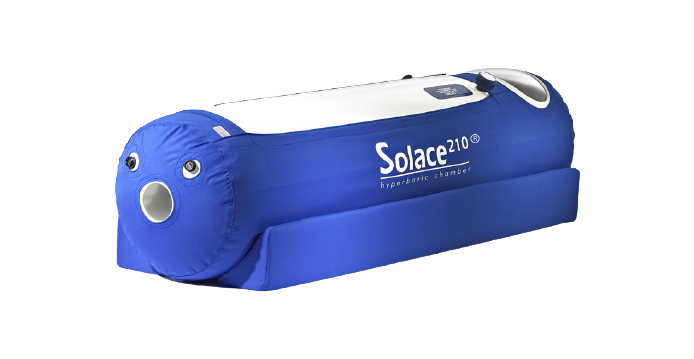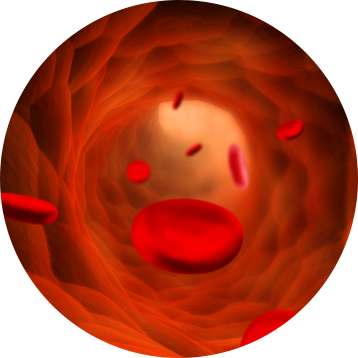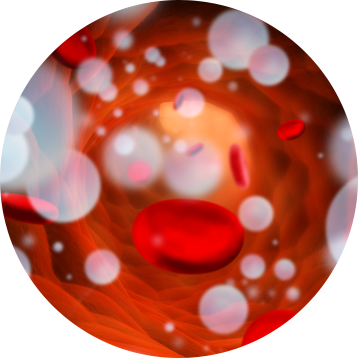
Hyperbaric oxygen chamber (HBOT) is the medical use of oxygen in a pressurized environment, at a level higher than 1 atmosphere absolute (ATA).
Increased pressure allows for oxygen to dissolve and saturate the blood plasma (independent of hemoglobin/red blood cells), which yields a broad variety of positive physiological, biochemical and cellular effects. This noninvasive therapy is the most trusted way to increase oxygen levels to all organs of the body.
The typical session lasts for 60-90 minutes, during which the patient lies down and breathes normally. HBOT has been demonstrated in several clinical studies to enhance the body’s innate ability to repair and regenerate.
It is used as an adjunct therapy to complement and enhance the healing process in both chronic and acute conditions. Contact us now and start your journey for a better and healthier life!



Hyperbaric oxygen therapy (HBOT) is the medical use of oxygen in a pressurized environment, at a level higher than 1 atmosphere absolute (ATA). Increased pressure allows for oxygen to dissolve and saturate the blood plasma (independent of hemoglobin/red blood cells), which yields a broad variety of positive physiological, biochemical and cellular effects.
This noninvasive therapy is the most trusted way to increase oxygen levels to all organs of the body. The typical treatment lasts for 60-90 minutes, during which the patient lies down and breathes normally.
It’s like when you purchase a bottle of soda, the CO2 (carbon dioxide) gas bubbles are under pressure, which decreases the size of the bubbles enough that they dissolve into the liquid. Therefore, you are unable to see them.
When pressure is released, the volume of each bubble increases and the bubbles appear. While an individual is under pressure, the oxygen molecules decrease in size and are able to dissolve into the blood plasma.
This exponentially increases oxygen delivery throughout the body and makes it possible for oxygen to reach inflamed tissue and support optimal cellular and organ functionality.
Hyperbaric oxygen therapy (HBOT) is an all-natural, non-invasive treatment where a patient simply breathes 100% medical-grade oxygen at an increased atmospheric pressure.
HBOT can increase the oxygen concentration in the body by up to 1,200% —this gives it the potential to lead to extraordinary health benefits.

Hyperbaric oxygen therapy (HBOT) is a medical treatment that can be traced back to the 1600’s. In 1662, the first renowned chamber was built and operated by a British clergyman named Henshaw. He erected a structure titled, the Domicilium, that was used to treat a variety of conditions. In 1878, Paul Bert, a French physiologist, discovered the link between decompression sickness and nitrogen bubbles. Bert later identified that the pain could be ameliorated with recompression. The concept of treating patients under pressurized conditions was continued by the French surgeon Fontaine, who later built a pressurized mobile operating room in 1879. Fontaine found that inhaled nitrous oxide had a greater potency under pressure, in addition to his patients having improved oxygenation.
In the early 1900’s Dr. Orville Cunningham, a professor of anesthesia, observed that people with particular heart diseases improved better when they lived closer to sea level than those living at higher altitudes. He treated a colleague who was suffering from influenza and was near death due to lung restriction. His resounding success led him to develop what was known as the “Steel Ball Hospital” located along the shore of Lake Erie. The six story structure was erected in 1928 and was 64 feet in diameter. The hospital could reach 3 atmospheres absolute. Unfortunately, due to the depressed financial status of the economy, it was deconstructed during in 1942 for scrap.
Subsequently, hyperbaric chambers were later developed by the military in the 1940’s to treat deep-sea divers who suffered from decompression sickness. In the 1950’s, physicians first employed HBOT during heart and lung surgery, which led to its use for carbon monoxide poisoning in the 1960’s. Since then, over 10,000 clinical trials and case studies have been completed for numerous other health-related applications with the vast majority of results reporting resounding success.
Also referred to as on-label, these conditions have been approved by the FDA for HBOT and are generally covered by insurance.
*Approved by the Undersea Medical Society (UHMS), and not the FDA.
Conditions that have not yet been approved by the FDA. In general, off-label conditions are not covered by insurance.
Hyperbaric Oxygen Therapy is the use of prescribed high pressure oxygen to treat a variety of health conditions and diseases. Breathing pure oxygen under pressures greater than sea level increases the amount of oxygen carried by the blood, enabling the oxygen to be dissolved into the hard-to-reach plasma, lymph, and cerebrospinal fluids surrounding the brain and spinal cord. These fluids more easily carry the increased oxygen to affected and damaged areas at up to 1,200% the normal concentration, thus providing a greater opportunity for healing.
Hyperbaric Oxygen Therapy is an effective treatment for a variety of medical conditions either as a primary or adjunctive treatment. It is non-invasive with very few (and rare) potential side effects and has very few contraindications. The medical staff at HMS evaluates each patient to determine whether Hyperbaric Oxygen Therapy is appropriate. If the medical staff determines that Hyperbaric Oxygen Therapy is appropriate, they will customize a patient’s individual treatment protocol.
HMS is a full service free-standing provider of Hyperbaric Oxygen Therapy, able to care for patients with a wide range of medical conditions. The FDA currently recognizes Hyperbaric Oxygen Therapy for 14 medical conditions, all of which are generally covered by insurance. In addition, there are many other medical conditions that research has demonstrated efficacy. HMS serves both groups as long as the condition is supported by existing research or is consistent with the mechanisms of action of HBOT
At the start of the treatment session, oxygen immediately begins to circulate and the pressure gradually increase. The patient will generally start to feel a fullness sensation in the ears, similar to ascending or descending in an airplane. This fullness should only last about 10-15 minutes and an experienced HMS hyperbaric technician will guide the patient to relieve any ear pressure. Once treatment pressure is reached, patients relax and just breathe normally. Near the end of the treatment session, the hyperbaric technician will gradually decrease the pressure in the chamber, a process that lasts about 10 minutes. During this decompression stage, it is common for patients to experience a slight popping sensation in the ears as a result of the change in pressure.
HBOT is an all natural therapy with generally no, or temporary, side effects. However, mild irritation to the ear drum may occur in about 10% of patients. The technicians at HMS will be with you every step of the way to prevent this from occurring. Other side effects may include temporary vision changes, dizziness or lightheadedness. In very rare instances, oxygen toxicity may occur, however, risk of this is mitigated by our HBOT protocols and comprehensive patient screening process.
We recommend that patients avoid eating or drinking (specifically carbonated beverages) directly prior to treatment, unless medically required, to avoid the need to use the restroom or cause an upset stomach during the session. Some medications are incompatible with Hyperbaric Oxygen Therapy; a complete list of medications and supplements taken by the patient should be provided to the medical team during the initial consult, and updates should always be provided. To maximize the benefit of Hyperbaric Oxygen Therapy, smoking of any kind should be avoided during the course of a patient’s complete treatment protocol. Smoking causes vasoconstriction and accumulation of carbon monoxide and other wastes, all which are counterproductive to Hyperbaric Oxygen Therapy. Lastly, alcohol consumption should be avoided at least 8 hours prior to treatment.
At your consultation, the complete process and list of items that are allowed and not allowed will be reviewed. Each patient is provided 100% cotton scrubs, sheets, and blankets as well as a plastic cup with water, if desired. Most other items are not allowed into a hyperbaric chamber with 100% oxygen. Prior to entering the chamber, an HMS technician must inspect and approve all items and garments. Examples of items prohibited inside the hyperbaric chamber include deodorant, lotion, perfume, mousse, gel, hairspray, makeup, jewelry, hair accessories, hearing aids, hard contact lenses, dentures, prostheses, nail polish (unless applied at least 48 hours prior to treatment), IV medication, and any clothing item that has buttons, snaps, Velcro, iron-on decals, or under-wiring. The HMS technicians will make sure that these policies are followed for every treatment session.
Many patients sleep, watch TV, or a movie. For your enjoyment, each hyperbaric chamber at HMS is paired with its own TV and DVD player. Patients are welcomed to watch their favorite TV programs, select a DVD to watch from our library, or bring DVDs of their own to watch.
Every HMS patient is unique and evaluated according to their condition and their response to therapy, which determines the number of treatments needed. Generally, patients require 30-40 sessions, though this could be more or less depending on the patient’s specific condition or circumstance. Hyperbaric Oxygen Therapy works cumulatively in the body and the greatest benefit is seen when treatments are regular (like going to the gym). Therefore, treatment sessions are typically scheduled 4-5 days a week.
There are a few contraindications to Hyperbaric Oxygen Therapy such as if you have an untreated pneumothorax, moderate to severe COPD, bullous lung disease, or are currently receiving certain chemotherapeutic agents. During the consultation with a member of our Medical Team, each patient is evaluated to determine whether Hyperbaric Oxygen Therapy is a safe and appropriate course of treatment.
Hyperbaric Oxygen Therapy is generally covered by insurance for the 14 FDA approved medical conditions. Insurance generally does not cover Non-Covered conditions. In either case, insurance will most likely cover the consultation visit, regardless of condition. Please note that at HMS we offer payment plans and financial assistance programs where treatment of a condition is not covered by insurance.
Our policy is to do our best to accommodate all candidates for Hyperbaric Oxygen Therapy.
At the initial consultation, each patient’s condition is evaluated to determine that Hyperbaric Oxygen Therapy is appropriate and a baseline marker is set. Then, during each HBOT visit, patients are monitored by a trained Hyperbaric Technician and a member of the Medical Team (link to medical team page). Every visit is documented with a specialized electronic medical records system to help track each patient’s progress. Additionally, formal evaluations are performed following the completion of every ten treatment sessions and upon completion of the treatment protocol.
Each of our facilities uses state-of-the-art monoplace hyperbaric chambers. These chambers are made of metal and acrylic which differ from the soft or mild variety in that they deliver 100% oxygen vs. room air (which is only about 20% oxygen), and are able to reach greater atmospheric pressure levels. This allows for the treatment of a wider variety of health conditions more efficiently and effectively.
Covered Conditions are conditions that have been approved by the Food and Drug Administration for hyperbaric treatment and are generally covered by insurance.
Non-Covered Conditions are conditions that have not yet been approved by the FDA for hyperbaric treatment. In general, off label conditions are not covered by insurance.
For more information about on and off label designations, please visit the FDA’s website at www.fda.org.
Yes, many conditions have very promising research to support the use of HBOT. We are continually compiling a library of research on many of these conditions, which can be found on our Conditions page.
In the U.S., there are 14 FDA approved conditions. In Europe, however, there are over 40 approved indications. In Japan and China, there are over 60.
The benefits of HBOT for certain conditions considered Non-Covered are well documented in supporting research and through the experience of patients around the world and at HMS. Core to our mission is to help and provide access to all patients who may benefit from HBOT. We believe HBOT can enhance the quality of life and well-being of patients that have many conditions that are considered Non-Covered.
There is extensive research available for many Non-Covered conditions that support its use. Through this research and our experience with the science of HBOT, also referred to as the mechanisms of action, we are able to apply this understanding to the underlying factors of various conditions and evaluate if HBOT is appropriate for a patient’s condition.
Yes. Research is ongoing and there are movements underway to approve traumatic brain injury (TBI) and post concussion syndrome, in particular. However, the FDA approval process and requirements are quite extensive. While the therapeutic benefits of HBOT have been understood for decades, if not centuries, many of the conditions that are considered Covered, such as Diabetic Foot Ulcers and Non-Healing Wounds, were only approved relatively recently. As the FDA approval process can take quite some time, because a condition is currently considered Non-Covered, that is not necessarily a reflection on the effectiveness of HBOT for that condition.

Address: 12720 Hillcrest Rd, Dallas, TX 75230